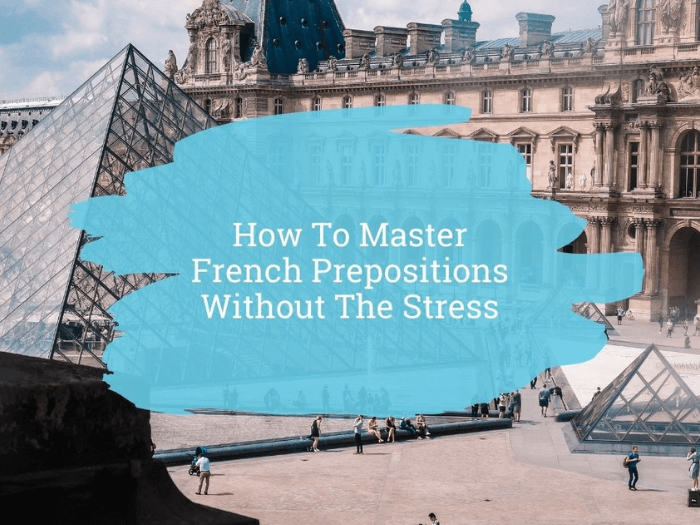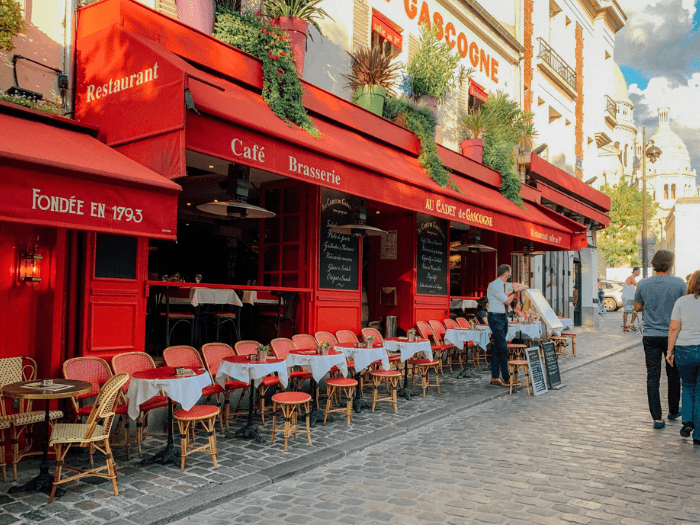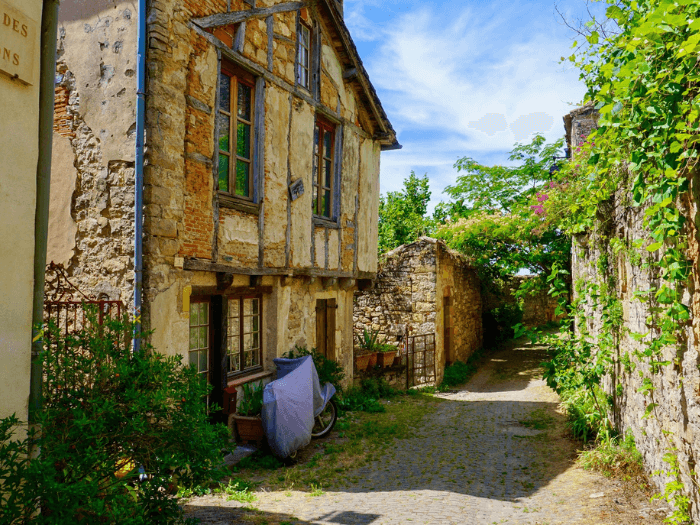
When you learn French, French prepositions are likely to cause you trouble. A big part of mastering them simply comes through use, and there’s nothing that can replace this.
However, there are still some useful tips, tricks and shortcuts that can help you master the basics – and that’s what I’ll try to give you in this post.
By the way, if you want to learn French fast and have fun while doing it, my top recommendation is French Uncovered which teaches you through StoryLearning®.
With French Uncovered you’ll use my unique StoryLearning® method to learn French naturally through story… not rules. It’s as fun as it is effective.
If you’re ready to get started, click here for a 7-day FREE trial.
What Are French Prepositions And Why Are They So Tricky?

Prepositions are those small words like “to”, “in” or “by” that tell you how different parts of a sentence are related to each other.
The problem is, each language has its own set, and although sometimes there are direct equivalents, often preposition usage varies significantly between languages.
For example, while the French proposition après has the direct English equivalent “after”, the preposition à can be translated by “at”, “in”, “to”, “of”, “by” or others, depending on its function.
Similarly, the English preposition “in” can be translated by dans, à, en, de and more in French.
If you look in almost any grammar book, you’ll find a list of French prepositions in alphabetical order, usually followed by a list of English prepositions for cross-reference.
For this reason, I’m not going to give you another exhaustive list here. Rather, I’m going to focus on some of the most important areas to introduce you to the French prepositions that will be most useful.
After that, mastering the rest will just be a matter of exposure and practice. So let’s jump in and get started!
French Prepositions Of Place

One of the most important uses of prepositions is expressing place, so here are some of the most common French prepositions of place.
À Often Means “At” Or “In”
To say where something is, French preposition à is most frequently used and when used to express location, it can be thought of as meaning “at”.
However, in English, sometimes we would also use “in”.
For example, we say:
- À l’école (At school, at the school)
- À l’hôpital (At the hospital, in hospital)
- Au café (At the café)
- À la banque (At the banque)
- Au village (In the village)
- À chaque endroit (At each place)
- Au lit (In bed)
- Au ciel (In the sky)
Note that when used with masculine nouns, à is combined with le to make au.
With cities, we usually use à, like this:
- À Paris (In Paris)
- À Madrid (In Madrid)
However, to say “in town”, “in the town” or “in the city”, we use en ville:
- Je suis en ville (I’m in town/in the town/in the city)
With Countries
When using French prepositions for countries, there is a special rule to follow: for masculine countries beginning with consonants, you use au – while feminine countries and masculine countries beginning with a vowel, you use en:
- Au Maroc (In Morocco)
- Au Japon (In Japan)
- En France (In France)
- En Irlande (In Ireland)
- Au Laos (In Laos)
- En Chine (In China)
- En Iran (m) (In Iran)
However, for plural countries, you use aux regardless of gender:
- Aux États-Unis (mpl) (In the USA)
- Aux Philippines (fpl) (In the Philippines)
French Départements And Regions, English Counties, States And Provinces In Other Countries
To talk about French departments and regions, English counties and provinces and states in other countries, use dans:
- Dans le Cambridgeshire (In Cambridgeshire)
- Dans le Gers (In (the) Gers)
- Dans le Sichuan (In Sichuan)
- Dans le Tamil Nadu (In Tamil Nadu)
However, for French regions, the rules are different – use en (with no article) for feminine regions and dans (with an article) for masculine regions:
- En Normandie (In Normandy)
- Dans le Périgord (In Périgord)
Islands

For big European islands, we use en whereas, for smaller islands, we use à – for example:
- En Sicile (In Sicily)
- En Corse (In Corsica)
- À Ibiza (In Ibiza)
- À Chypre (In Cyprus)
For islands further away from Europe, the preposition is usually à, regardless of size:
- À Taiwan (In Taiwan)
- À Borneo (In Borneo)
- À Sumatra (In Sumatra)
However, this is not always the case. For example, we say:
- En Martinique (In Martinique)
- En Guadeloupe (In Guadeloupe)
You could argue that the last two are départements of France, but when it comes to islands, perhaps the best idea is just to remember each one individually.
À vs Dans
Sometimes, it is possible to use either à or dans with a subtle difference in meaning. In these cases, choosing à expresses the general idea of the location whereas dans emphasises the fact of being inside the place.
Look at these examples:
- Il est à l’école (He’s at the school)
- Il s’est caché dans l’école (He hid in the school)
In the first sentence, we’re just stating where the person is – but in the second, we are placing more emphasis that he is inside the school, hiding inside the building.
It works the same when considering French prepositions for cities:
- Je travaille à Londres (I work in London)
- C’est désagréable de conduire dans Londres (It’s unpleasant to drive in London)
The first sentence is merely stating the location, but in the second, the emphasis is on it being unpleasant to drive within the city. However, if you didn’t want to stress it in this way, you could also say c’est désagréable de conduire à Londres and it would still be correct.
Over, Under, Above, Below And Between
When saying something is over, under, above or below something, French is quite similar to English. The preposition in French for the word “on” is usually sur while above is usually au-dessus de.
Like in English, the difference is usually determined by whether there is contact:
- Le chat est sur la table (The cat is on the table)
- Il y a des nuages au-dessus de la montage (There are clouds above the mountain)
As you can see, since the cat is touching the table, we use sur – but because the clouds are not touching the mountain, we use au-dessus de.
With the equivalent words sous and au-dessous de, the difference is more subtle. Here, no contact is implied, and au-dessous de is used when you want to emphasise that something is completely under, underneath or below something, like this:
- Le chat est sous la table (The cat is under the table)
- Son appartement est au-dessous du mien (His flat is below mine)
The word for “between” is entre. However, in other expressions not related to a physical position, entre can be translated with other prepositions in English.
For example:
- Un endroit entre les deux villages (A place between the two villages)
- Entre amis (Between/among friends)
- Vous êtes entre amis (You’re among friends)
- Entre ses mains (In his hands (figurative sense))

Chez
A uniquely French preposition of place is chez, and you usually use it to express “at somebody’s house”, like this:
- Chez Jean (At Jean’s house, At Jean’s place)
- Chez lui (At his place)
“On TV”, “On The Radio”, “On The Menu” etc
When talking about TV and radio programmes, the preposition to use is à and not sur. If you use sur, it means there is something on top of the physical TV or radio.
Here are some examples:
- Il est passé à la télé (He was on TV)
- Je l’ai entendu à la radio (I heard it on the radio)
- Il y a du foot à la télé (There’s football on TV)
But:
- Le chat est assis sur la télé (The cat is sitting on the TV)
Expressions like “on the menu” also follow this pattern:
- Au menu (On the menu)
Other Prepositions Of Place
There are also a number of other French prepositions of location that work more or less the same as in English. Here are just a few examples:
- Devant l’église (In front of the church)
- Derrière le bar (Behind the bar)
- À côté de chez elle (Next to her place)
French Prepositions Of Movement And Direction

As well as for location, we also use prepositions to indicate movement and direction. Here are some of the most important.
Direction “To” And “From”
In English, the basic preposition we use to indicate direction towards something is “to”, and in French, this is often translated by à. Here are some examples:
- Il va à l’école (He goes to (the) school)
- Je vais à Delhi (I’m going to Delhi)
You’ll notice that the preposition for “to” in French is the same as the one for “at”. However, the meaning is always clear from the context.
However, when talking about places that use en for location, for example, feminine countries and some islands, you should use en for direction too.
The rule is to always use the same preposition for direction as for place:
- Je vais en France (I’m going to France)
- Il va en Martinique (He's going to Martinique)
- Je vais en ville (I’m going to town)
- Je vais à Ibiza (I’m going to Ibiza)
- Ils vont à Sumatra (They're going to Sumatra)
For direction “from”, the preposition is de:
- Il arrive de France (He’s coming/arriving from France)
- Il est parti de la maison à 7h (He left (from) the house at 7am)
Travelling “By”
When travelling in a vehicle, the preposition is usually en:
- En voiture (By car)
- En taxi (By taxi)
- En bus (By bus)
However, with some other ways of travelling, you use à. The difference is that you are not considered to be “inside” a vehicle.
For example:
- À pied (On foot)
- À cheval (On horseback/by horse)
- À vélo (By/on a bicycle)
“Through” – Par And à Travers
To express “through”, the preposition is usually par:
- Je le regarde par la fenêtre I’m watching him through the window (or “out of the window”)
- On passe par le tunnel (We pass/go through the tunnel)
- Il est sorti par le salon (He left through the living room)
However, “through” is sometimes expressed by à travers, which often implies some kind of difficulty or that something is blocking the passage:
- Il est passé à travers la foule (He passed/came through the crowd)
- J’entends la musique à travers le mur (I (can) hear the music through the wall)
French Prepositions Of Time

Another major category are French prepositions of time, so let’s look at some of the most important ones now.
Saying The Time When Something Happens
To say the time when something happens, you usually use à, which in this case, is the equivalent of “at” in English.
- Je suis rentré à 22h (I got back at 10pm)
- Il s’est endormi à minuit (He fell asleep at midnight)
Days, Months, Seasons, Years
To say which month, season or year something happened, the preposition is en:
- En avril (In April)
- En été (In summer)
- En 1980 (In 1980)
An exception is printemps, “spring” – for this, use au:
- Je suis né au printemps (I was born in spring)
To say which day something happened, in English, we use the proposition “in”, but in French, you don't need a preposition:
- Je vais aller lundi (I’m going to go on Monday)
In French, to say that something happens repeatedly on a particular day – for example, “on Mondays”, there is still no preposition, but you precede the day with le, like this:
- Je vais à la boxe le vendredi (I go to boxing on Fridays)
“For” And “Since”
To say how long an action has lasted, you use depuis – and depending on the sentence, it can be translated with either “for” or “since”, like this:
- J’apprends le Hindi depuis deux ans (I’ve been learning Hindi for two years)
- J’habite en Australie depuis 2015 (I’ve lived in Australia since 2015)
Note here that to say how long you have been doing something, if you still do it now, you should use the present tense in French and not the French perfect tense.
On the other hand, if you are talking about a completed period in the past – and the focus of the sentence is the duration of the action – the preposition to use is pendant:
- J’ai appris le piano pendant deux ans (I learnt the piano for two years)
- Pendant longtemps (For a long time)
However, if the emphasis is on the duration rather than the action, no preposition is required in French whereas English usually uses “for”:
- Il est resté deux semaines (He stayed (for) two weeks)
In this example, the emphasis is on how long he stayed, “two weeks”. Compare this with the example before where the action is on the action, “learning the piano”.
An exception is when talking about an intended duration in the future, in which case, you should use pour – although sometimes, in informal French, no preposition is used:
- Je vais rester pour deux semaines (I’m going to stay for two weeks)
- Je vais rester deux semaines (I’m going to stay for two weeks)
That said, again, if the focus is on the action, you should use pendant, even in the future:
- Je vais étudier intensivement pendant deux semaines (I’m going to study intensively for two weeks)

“In” With Time Expressions
To say how long into the future something will happen, in English, we use “in” – and it works the same in French with dans, like this:
- Il va arriver dans une demi-heure (He’s going to arrive in half an hour)
- Ils vont se marier dans trois mois (They’re going to get married in three months)
However, to say how long something will take, use en. Here’s a pair of examples that illustrate this point clearly:
- Il terminera le travail dans deux semaines (He will finish the job in two weeks)
- Il terminera le travail en deux semaines (He will finish the job in two weeks)
As you can see, in English, the translation is the same. However, the first sentence tells you that the end date will be two weeks from now while in the second sentence, we are saying how much time it will take him to complete the job.
For the second sentence, an alternative translation could be “it will take him two weeks to finish the job”.
“During”
To express “during”, the preposition is pendant:
- Pendant mon enfance (During my childhood)
- Pendant les vacances (During the holidays)
Avant And Après Meaning “Before” And “After”
When referring to time, these two prepositions work more or less the same as in English:
- Avant le match (Before the match)
- Avant le travail (Before work)
- Après la naissance de son enfant (After the birth of his child)
- Après 22h (After 10pm)
Vers To Give An Approximate Time
To indicate an approximate time, use vers:
- Vers 22h (At about 10pm)
This preposition can also be used to indicate approximate ages:
- Il a vers 50 ans (He’s about 50 (years old))
“Until” Is usually Jusqu’à
To express “until” use the preposition jusqu’à:
- Je travaille ici jusqu’à la semaine prochaine (I’m working here until next week)
However, to express the idea of “not until”, use pas avant – in English, the same idea can also be expressed as “not before”:
- Je ne partirai pas avant la semaine prochaine (I won’t leave until next week)
- Je ne partirai pas avant la semaine prochaine (I won’t leave before next week)
French Prepositions Of Possession

French also uses prepositions to express possession, so here’s how it works.
De And à For Possession
The preposition de is usually translated by “of”, and in French, it is used to talk about who something belongs to:
- La voiture de Marie (Marie’s car)
However, with disjunctive pronouns (words like moi, toi etc.), you use à instead, like this:
- C’est à moi (It’s mine)
- C’est une amie à lui (She’s a friend of his)
À vs De
Language learners can sometimes get confused regarding the French prepositions à and de.
However, this can be contrasted with the same construction using à, which tells you about the kind of container you are talking about. Look at this pair of examples:
- Un verre de bière (A glass of beer)
- Un verre à bière (A beer glass)
In the first one, we are talking about a glass filled with beer. It could be any kind of glass – for example, a wine glass – but we are saying that it contains beer.
In the second of our French prepositions sentence examples, we are saying what type of glass it is. It could be filled with beer, but it could just as easily be filled with wine or rice – or it could be empty. But the type of glass we are talking about is one that is intended for beer.
A Big Topic – But One You Can Easily Master With Practice

Prepositions are a big topic, and it’s impossible to give you a comprehensive French prepositions list of all the possibilities in a short post like this – so I haven’t tried.
Rather, I’ve given you a selection of some of the most common French prepositions and the ones that tend to catch learners out at the beginning.
With prepositions in French, there’s nothing to ‘understand’, and often there’s no logic – so the only thing to do is remember how to use prepositions in French.
However, in this post, you have already seen a good proportion of the most awkward examples – and the rest will come with time and practice.

Olly Richards
Creator of the StoryLearning® Method
Olly Richards is a renowned polyglot and language learning expert with over 15 years of experience teaching millions through his innovative StoryLearning® method. He is the creator of StoryLearning, one of the world's largest language learning blogs with 500,000+ monthly readers.
Olly has authored 30+ language learning books and courses, including the bestselling "Short Stories" series published by Teach Yourself.
When not developing new teaching methods, Richards practices what he preaches—he speaks 8 languages fluently and continues learning new ones through his own methodology.










































